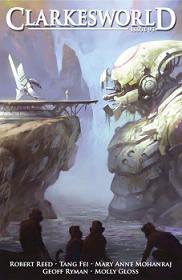 Clarkesworld #93, June 2014
Clarkesworld #93, June 2014
Reviewed by Ryan Holmes
Clarkesworld #93 contains three original stories and two reprints. Only the original stories are reviewed.
“wHole” by Robert Reed is narrated mostly from the point of view of an automobile as it drives along with an unclear number of passengers. After some time reading about the car wondering about the man and woman in the front seats, wondering about why it doesn’t know where it is or where it’s going, the point of view switches to the man as he tries to remember the way to their destination. The destination is some random tree on the side of the road, and the man starts digging a hole as he monologues about him and his friends creating ‘wHole,’ a research and development organization. Eventually, the story reveals its theme, I think, which is about the futility of space travel, I think, of which there is none in this story. The man, who drew rockets as a child, believes he’s stumbled upon an epiphany for solving this problem: the miniaturization of self-replicating machines. Although, how this would allow humans to colonize the stars is difficult to imagine and isn’t addressed. Nor is it successful, and the story takes a sharp turn, jumping into the point of view of the woman, who up until this point has played the presumed roles of disgruntled wife to the drugged victim of a psychopath. Now she reveals herself to be, well, I’m not sure, some product of the man’s miniature creations, though why she looks human isn’t explained. A long monologue follows where the woman recants her long life over only a span of seconds and her failure to contribute anything new to the collective. At some point, space travel becomes irrelevant and thought the only driver, but how the two are related is unclear. From thought, the story derives that the only solution is to not create machines in the first place. Finally, the story returns to the car, who finds itself commanded to drive into the hole.
Tang Fei’s “Pepe” is translated by John Chu and takes place in an amusement park. It involves a strange story about two children, a boy and a girl (Pepe), who are actually artificial creations who can’t speak unless telling a story. People discover them and wage war on them. Why isn’t revealed, but they identify the other children by asking them questions, which they can’t answer because they can only tell stories, except for the boy, who perceives the answers as just another story. All of this is narrated by the boy as they get on a couple rides. Along the way, we discover that Pepe and the boy don’t get along but are stuck with each other, and that Pepe is mentally disturbed. This story jumps around a great deal, and understanding its theme is difficult. This is perhaps compounded by the language barrier. John Chu does what I can only assume is a decent job translating Fei’s story into English, obviously a secondary language for Chu. Why the editor(s) at Clarkesworld didn’t copy-edit the translation is difficult to imagine. Perhaps they wanted Fei’s story to be as close to the original version as possible. Unfortunately, the story suffers as a result.
“Communion” by Mary Anne Mohanraj takes place on another world after a terrible battle. Chaurin, an alien, has come to claim the body of his brother, who sacrificed himself somehow during the terrible battle. Chaurin meets Amara, who is planting jasmine at the base of the memorial because bougainvillea won’t grow off of Earth, and asks her for his brother’s remains. Amara, who only knew his brother for a few hours yet somehow feels a deep kinship toward the alien, takes Chaurin to Narita. At this point, Narita delivers the brother’s remains, which fit into a small tin, to Chaurin and gets to explain to Amara all about the alien’s custom of eating the flesh of their dead relatives. She then asks Chaurin if she can eat the flesh of his brother too because she wants to honor this alien that died for them in some unknown way defending them from some unknown enemy, though we’re told there’s more fighting going on across the stars.
What had the makings of being an interesting alien warrior is stripped of all its masculinity when we learn the alien is a match maker in addition to a cannibal. Why do they eat their dead relatives? Narita is smart enough to tell poor ignorant Amara this as well. A genetic flaw requires the women to ingest an enzyme which they can only get by eating the father’s flesh. How the first woman discovered this is not explained, but we are told that it’s no longer necessary but has become a religious custom. Then the story jumps, through Chaurin’s point of view, to the conflict between Narita and Amara, who are same sex partners. Why Chaurin would refer to them as mates when they can’t is bizarre, but he’s more than happy to try to fix their relationship problems, which center around whether or not to genetically enhance their future child. Amara is not enhanced. Narita is. Chaurin feels this could take some effort and time, which is not why he’s there, but he appears to stay and help anyway.